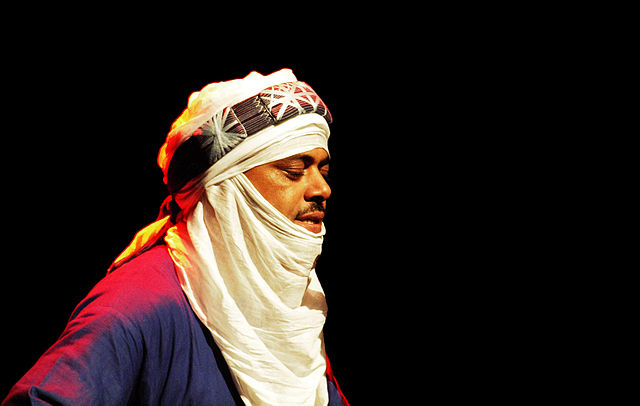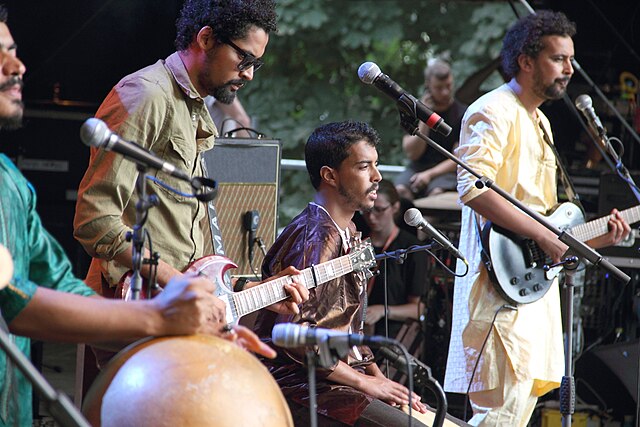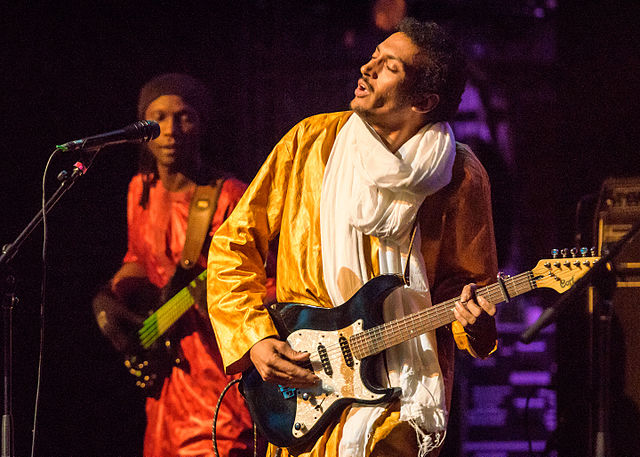The Rise of Desert Blues

By: Mehdi El Merini / Arab America Contributing Writer
The vast expanse of the Sahara Desert, with its sweeping dunes and harsh, arid landscapes, has given birth to a unique and evocative music genre known as Desert Blues. Rooted in the traditions of the Tuareg people, this style blends traditional Saharan rhythms with modern guitar-driven melodies, creating a hypnotic and deeply soulful sound. At the heart of this genre are pioneering artists such as Tinariwen, Imarhan, and Bombino, whose music has transcended borders, carrying the stories of their people to the global stage.
Origins and Influences of Desert Blues
Desert Blues is often described as the North African counterpart to American blues music, a comparison that stems from its melancholic tones, repetitive chord progressions, and deep-rooted themes of struggle and resistance. The Tuareg, a nomadic Berber people spread across Mali, Niger, Algeria, and Libya, have long expressed their identity and historical experiences through music and poetry.
The rise of Tuareg guitar music can be traced back to the 1980s, during the Tuareg rebellion in Mali and Niger. Displaced and marginalized, many Tuareg youth found solace in music, blending their traditional rhythms with the influence of Western rock and blues. Inspired by artists like Ali Farka Touré, Jimi Hendrix, and John Lee Hooker, they adapted the electric guitar into their folk traditions, creating a distinct Saharan soundscape.
Tinariwen: The Pioneers of Tuareg Rock
Any discussion of Desert Blues must begin with Tinariwen, the legendary collective often credited with defining the genre. Founded in the late 1970s by Ibrahim Ag Alhabib, Tinariwen emerged from the experiences of Tuareg exile and rebellion. Their music tells stories of displacement, political struggle, and the longing for a homeland.In the 2000s, Tinariwen gained international recognition, particularly after the release of albums like Aman Iman: Water is Life (2007) and Tassili (2011), the latter winning a Grammy Award for Best World Music Album. Their hypnotic rhythms, raw vocals, and intricate guitar work have captivated global audiences, influencing countless musicians beyond the Sahara.

Imarhan: The New Wave of Tuareg Music
Following in Tinariwen’s footsteps, the band Imarhan, formed in the Algerian city of Tamanrasset, represents the next generation of Tuareg rock. While rooted in traditional Tuareg music, Imarhan incorporates a modern sensibility, drawing from funk, psychedelic rock, and even pop.
Their self-titled debut album Imarhan (2016) and follow-up Temet (2018) showcased their dynamic approach, fusing high-energy riffs with socially conscious lyrics that explore themes of cultural identity, globalization, and the challenges faced by Tuareg youth today. With a fresh and evolving sound, Imarhan is playing a key role in pushing Desert Blues into new sonic territories while staying true to its roots.
Bombino: The Jimi Hendrix of the Sahara
One of the most internationally recognized Tuareg musicians today is Bombino, a Nigerien guitarist and singer who has been dubbed the “Jimi Hendrix of the Sahara” due to his electrifying guitar style. Born Omara Moctar, Bombino was raised in Agadez, a city with a rich musical heritage. His early exposure to Western rock, particularly artists like Mark Knopfler and Santana, shaped his unique approach to Tuareg guitar music.
His breakout album Agadez (2011) put him on the global map, and his collaborations with renowned producers like Dan Auerbach of The Black Keys (on the album Nomad in 2013) further expanded his reach. Bombino’s music exudes both defiance and celebration, reflecting the struggles of the Tuareg people while embracing the freedom and joy that music can provide.

The Political and Cultural Significance of Tuareg Music
Beyond its mesmerizing melodies and intricate guitar work, Desert Blues is deeply tied to the political and social struggles of the Tuareg people. For decades, Tuareg communities have faced displacement, government oppression, and economic hardship. Their music serves as a form of resistance, a means of preserving their history, and a way to unite their scattered communities.
Tinariwen’s songs often address themes of exile and rebellion, while Bombino’s lyrics speak of the need for peace and reconciliation. Imarhan’s music reflects the changing realities of younger Tuareg generations, who grapple with the push and pull between tradition and modernity.
Global Recognition and the Future of Desert Blues
Thanks to the internet and world music festivals, Tuareg guitar music has reached audiences far beyond the Sahara. Bands like Tinariwen, Imarhan, and Bombino regularly tour in Europe, North America, and Asia, gaining devoted followings and influencing musicians across genres.
As the genre continues to evolve, newer artists are experimenting with electronic elements, jazz fusion, and even hip-hop, expanding the sonic possibilities of Desert Blues. However, at its core, the music remains a powerful expression of identity, resilience, and longing.
Desert Blues is more than just a genre—it is the voice of a people navigating the challenges of modernity while holding onto their rich cultural heritage. Whether through the pioneering work of Tinariwen, the innovative spirit of Imarhan, or the fiery guitar solos of Bombino, Tuareg music continues to mesmerize and inspire. As long as the desert winds blow across the Sahara, the soulful sounds of Tuareg guitar will endure, telling stories of resistance, hope, and an eternal connection to the land.
Check out our blog here!








